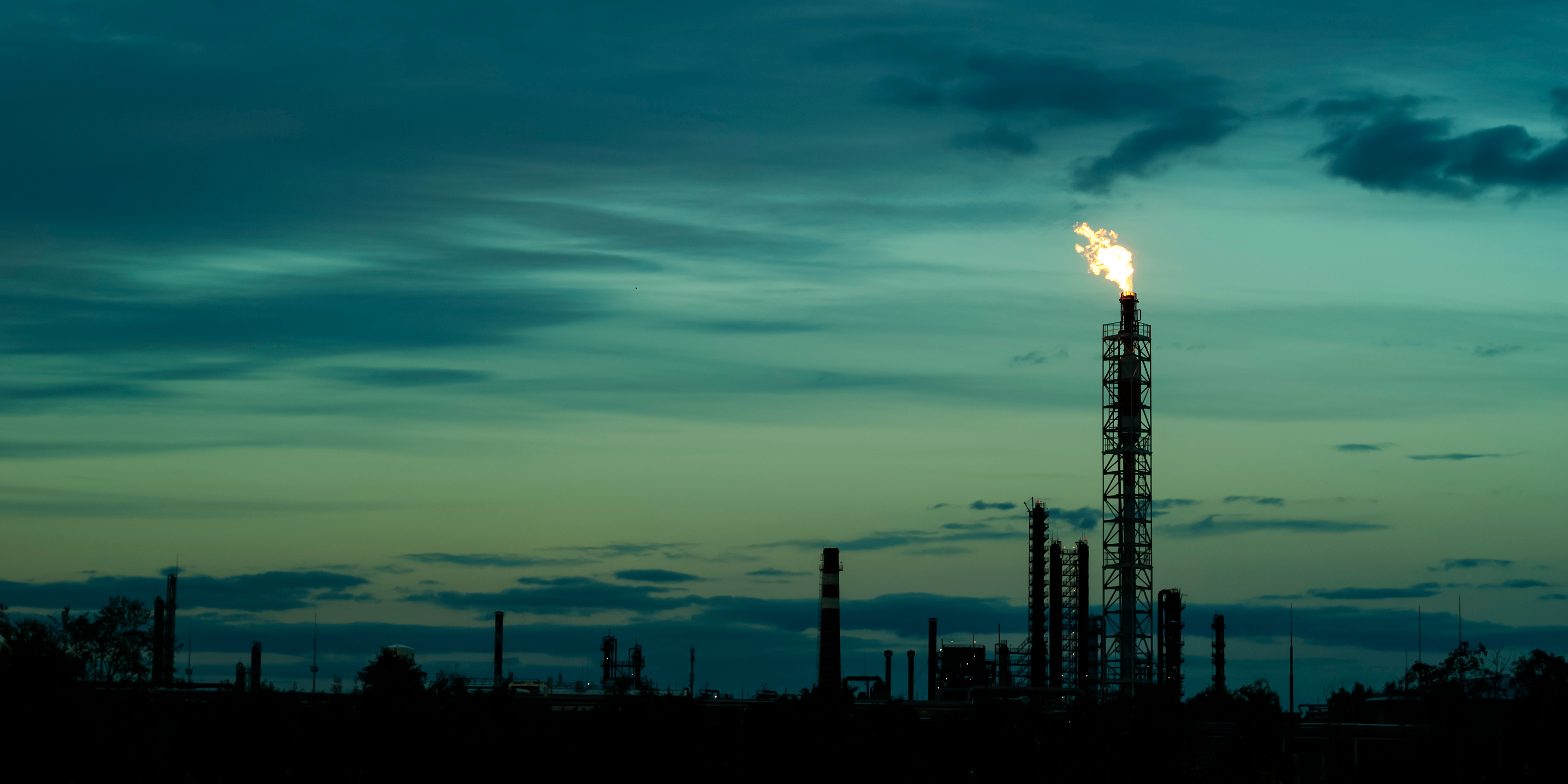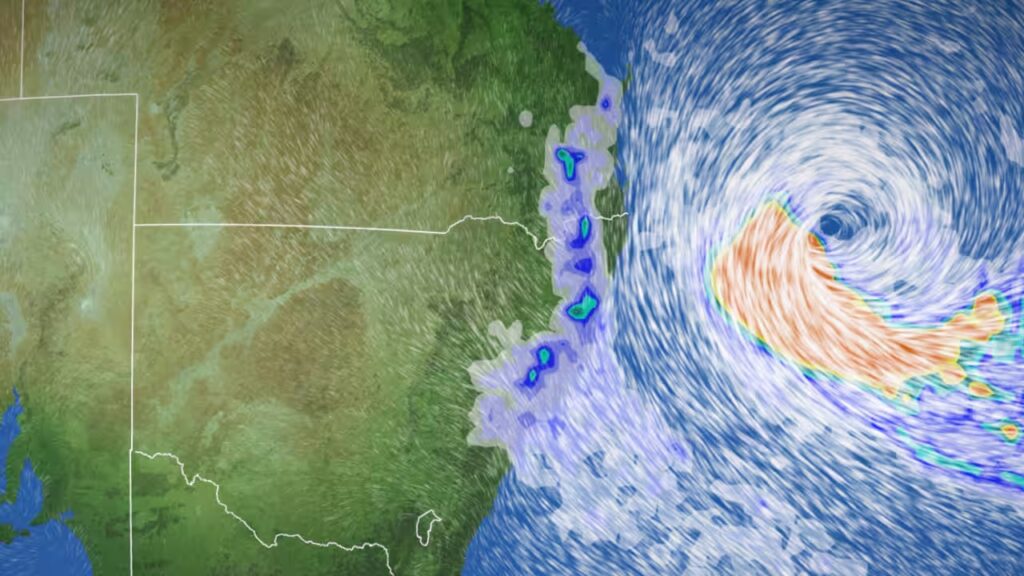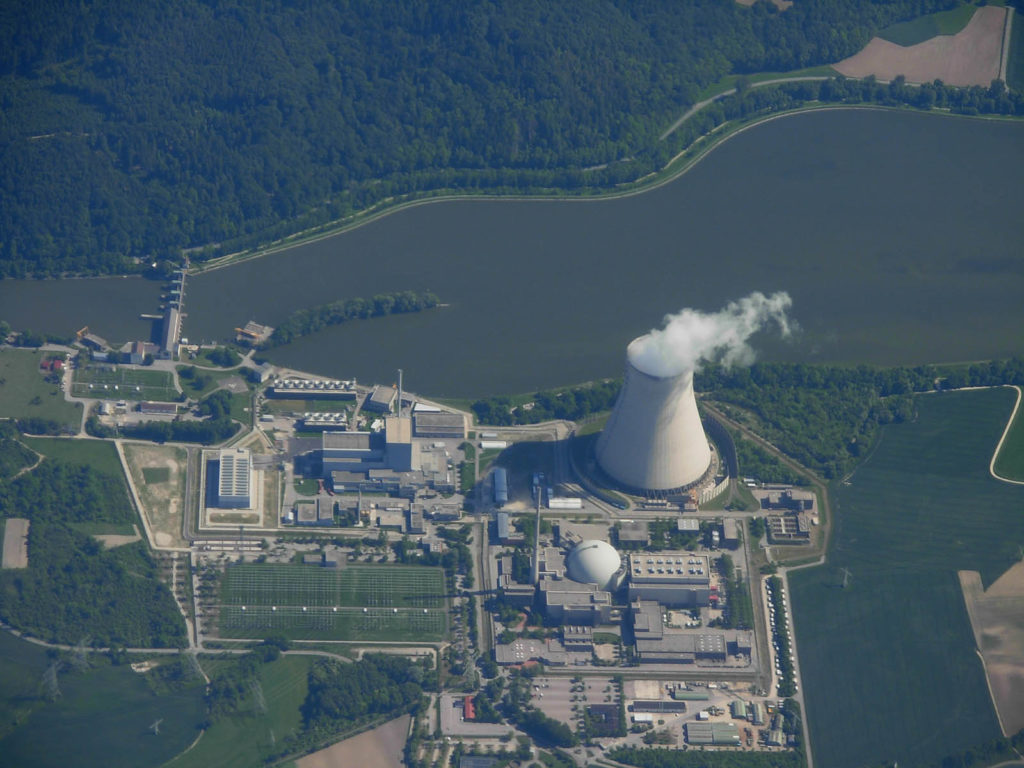Most people know that carbon dioxide is the number one culprit when it comes to climate change. But there’s another harmful greenhouse gas polluting our atmosphere and warming up our planet: methane. Methane is dangerous because it’s so effective at trapping heat. In fact, over a 20-year period it causes about 85 times the climate damage of carbon dioxide.
Australia produces an outsized share of global methane pollution due to our large fossil fuel mining and agriculture industries. In 2023, we produced almost four million tonnes of the stuff. We cause more methane pollution globally than many larger developed economies, including France, Germany, the UK and Canada. We produce about four to five times as much methane as would be expected based on our population. What’s worse is that coal and gas corporations may be under-reporting the methane they release by massive amounts. In fact, by as much as 60 percent.
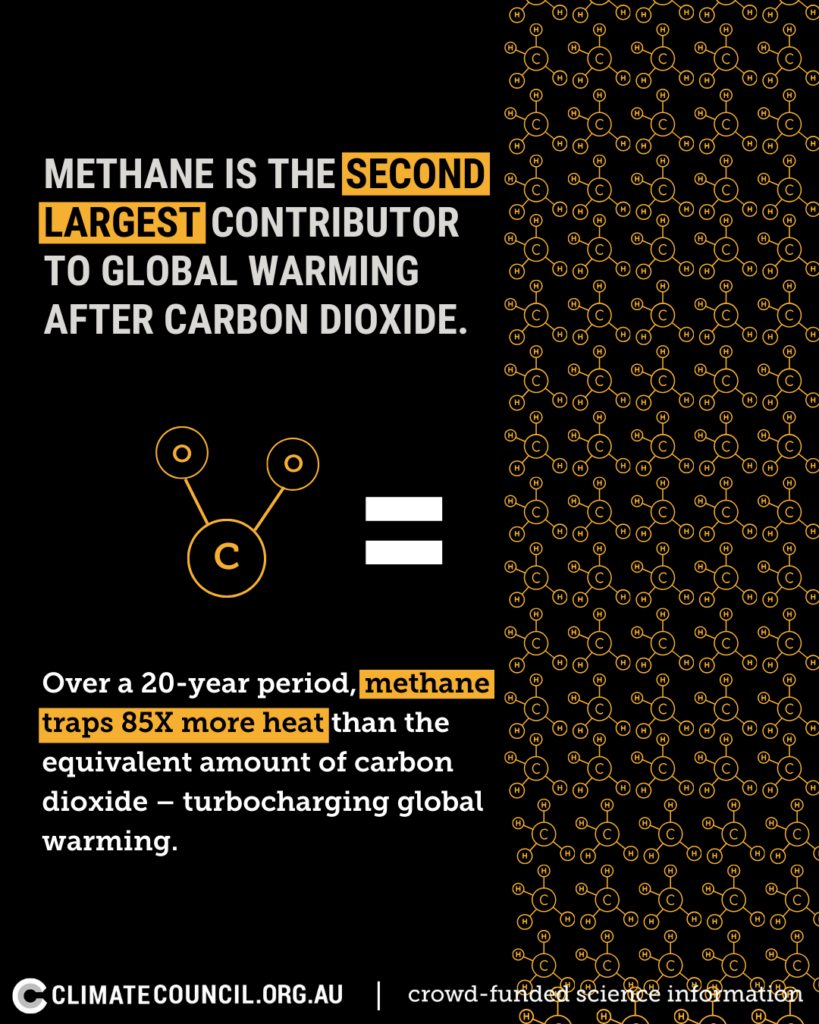
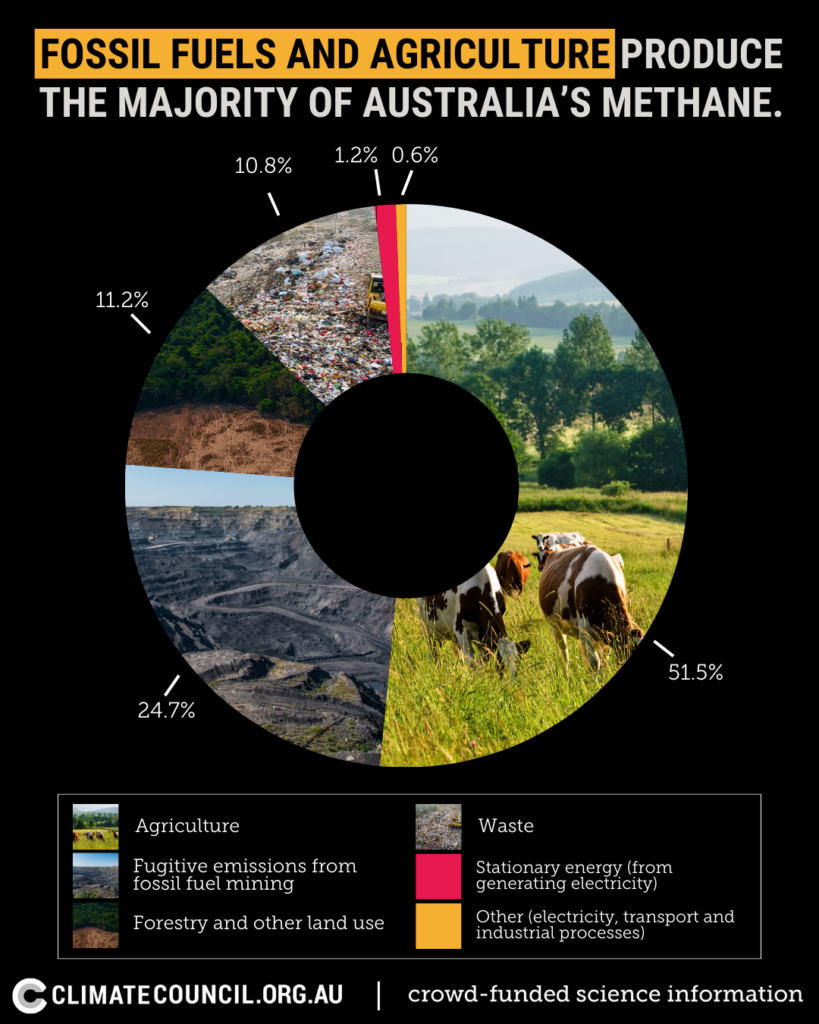
So what actually is methane?
Methane is a “live-fast, die-young” greenhouse gas, which is significantly more potent than carbon dioxide. Global methane pollution from human activities in 2023 is estimated to cause more warming over the next 20 years than the carbon dioxide from all passenger vehicles and coal-fired power stations combined for the same year.
Methane is a colourless, odourless and highly flammable gas that is the main component of the gas used today in our homes and businesses. As a potent greenhouse gas, methane significantly affects the earth’s temperature and climate system when released into the atmosphere, by trapping heat reflected from the Earth’s surface. As the second biggest contributor to global warming after carbon dioxide, methane is fuelling the unnatural disasters we are experiencing here in Australia and worldwide, like heat waves, floods and bushfires.
Like climate pollution from carbon dioxide, humans are also turbocharging methane pollution at record rates. Human activities like fossil fuel mining and agriculture are responsible for around half of the global methane emissions entering the atmosphere, with the remainder coming from natural sources like wetlands.
The concentration of methane in our atmosphere has reached its highest level in at least 800,000 years, with human activities responsible for almost all of its recent rapid rise.
The hidden methane in fossil fuel extraction
The fossil fuel sector is responsible for around a quarter of Australia’s methane pollution. This is because when coal and gas are mined and processed, large amounts of methane are either leaked or deliberately vented into the atmosphere. These methane emissions, known as ‘fugitive emissions’, are another source of climate pollution on top of the carbon dioxide produced when these fossil fuels are burned.
There is a growing awareness and concern that countries around the world may be significantly under-reporting their methane pollution. The likely reason for this is that generally methane levels are estimated – indirectly and loosely, based on things like the number of cows in a region or the tonnes of coal extracted from a mine – rather than directly measured.
The coal industry is likely the biggest culprit for under-reporting its methane emissions. New methods of tracking methane, such as remote sensing from aircraft or satellites, have quantified the methane pollution from six coal mines in Queensland’s Bowen Basin. The methane pollution accurately measured from these mines using new technology was equivalent to about half of the national total being reported from all coal mining in Australia, despite these mines producing only about seven percent of the country’s coal. This highlights major under reporting, and the critical need to accurately measure methane pollution from fossil fuel mining, as well as upgrade facilities and tighten regulations to cut methane pollution.
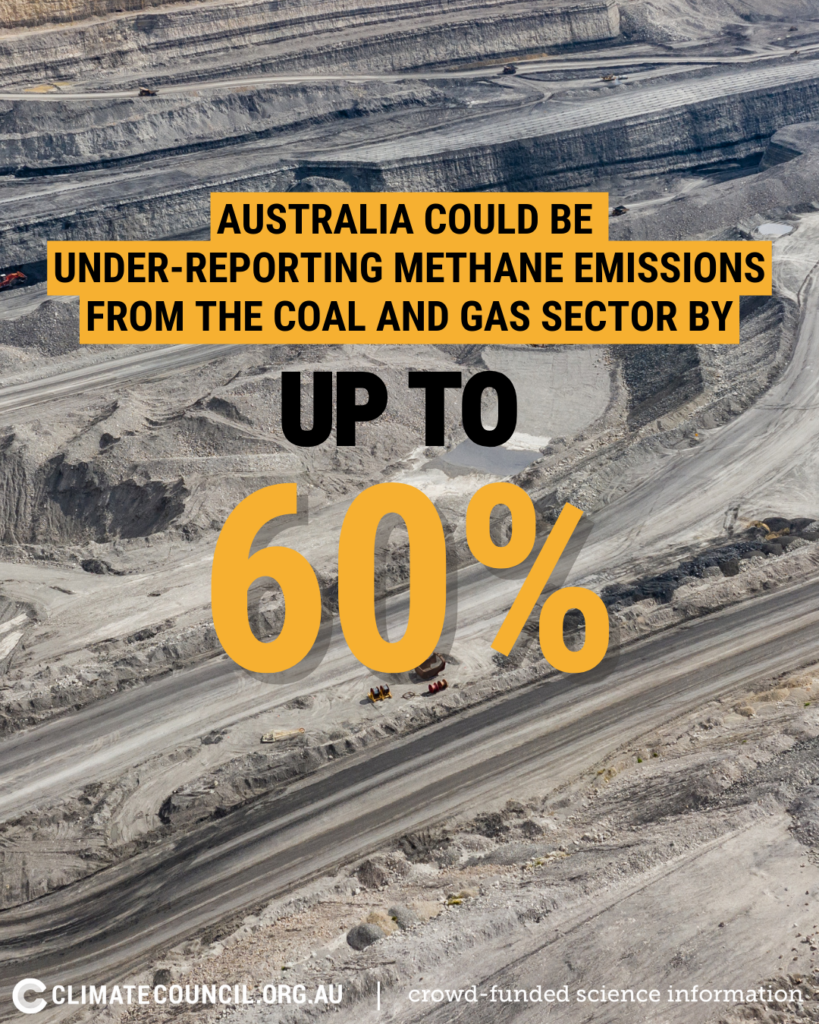
Garbage gas
The majority of organic waste, such as old banana peels and used coffee grinds, ends up in landfill where it releases methane as it decays. In fact, around 97 percent of landfill pollution is methane. The waste sector produces about 11 per cent of Australia’s methane pollution, which is mostly from organic matter decay. Additional sources include wastewater treatment, waste incineration, and the biological treatment of solid waste.
The solution is simple: we need to keep organic waste out of landfill. When organic waste is composted (in an environment where oxygen is present), all that nasty methane is prevented. Plus it’s great for your garden! What’s more, methane pollution from waste like sewage, food, and agricultural waste, can also be captured and used to generate electricity. This process produces what is known as ‘biomethane’ or ‘biogas’. This gas is chemically identical to fossil gas and can be transported in the same pipelines and used for industrial purposes. While biomethane is not expected to be a major alternative fuel replacing fossil gas, there are some limited and near-term uses from existing landfills and increasing how much methane is captured for this purpose is a positive way to displace fossil gas, and reduce methane pollution to our atmosphere.
Burp alert!
The Australian agriculture industry is responsible for a little over 50 percent of estimated methane emissions – the largest share of any single sector. Cutting climate pollution from agriculture – including methane – is a big challenge right now because there are fewer proven, scalable and affordable solutions.
The majority of climate pollution produced by agriculture is the methane produced by cows and other livestock such as sheep as their stomachs process plant matter. In 2022-23, methane released by beef and dairy cattle accounted for nearly 65 percent of the climate pollution from Australian agriculture.
Innovative solutions are being actively researched and developed to address methane emissions in agriculture. One promising example is Asparagopsis, a seaweed additive for cattle feed, which has demonstrated the potential to reduce methane emissions by up to 90 per cent. Another feed supplement, 3-NOP, is safe and effective at reducing methane emissions from cattle, with potential methane reductions dependent on the dose interval and diet. Both feed supplements need to be administered regularly, making them suitable for dairy and feedlot cattle, and less suitable for grazing cattle. Researchers are also exploring vaccines that target methane-producing organisms in animals, improved feed supplements, and selective breeding strategies to cultivate cattle that produce less methane.
What needs to be done?
We know we urgently need to slash methane pollution, as well as carbon dioxide, to keep climate change in check, and that starts by setting clear national targets backed up by action.
Along with more than 150 other countries, Australia signed the Global Methane Pledge to cut global methane pollution by at least 30 percent by 2030. Yet the Australian government has not published a plan to help meet this objective, and there aren’t any national or state methane reduction targets. Without concerted action, global methane pollution from human activities is expected to rise as much as 15 percent this decade, making unnatural disasters more common and more severe.
Cutting methane emissions from the fossil fuel industry is one of the easiest and cheapest ways to lower greenhouse gases and drive down harmful climate pollution. The Australian Government needs to hold fossil fuel corporations accountable for accurately monitoring, reporting and slashing methane pollution. This means:
- ensuring all coal and gas corporations directly measure and report their methane pollution, and stop relying on flawed estimates;
- ending approvals for new goal and gas projects, and requiring the most polluting mines to cut emissions as a condition for continued operation; and
- stopping underground coal mines from venting and flaring methane into the atmosphere, and requiring them to capture and destroy it instead, and banning all non-emergency flaring and venting of gas.
We also need easier and more accessible ways to dispose of organic waste so we cut methane pollution from landfill. Less than 40 percent of local governments provide a dedicated collection service for food and organic and garden organic (FOGO) waste so residents can separate this out from other waste for kerbside collection. By rolling out FOGO services across the country, we can compost organic waste and significantly cut climate pollution compared with landfilling. On existing landfill sites, we can also tighten up federal and state requirements to capture gas to use as biomethane.
Finally, we need to scale up our efforts to reduce methane in the agriculture sector. This means ramping up research to reduce the climate impacts of meat and dairy production, incentivising farmers to cut methane pollution from their animals, promoting protein alternatives like lab-grown meat and dairy products, and public education campaigns on the environmental and climate impact of different types of food.
The climate crisis is here. 2023 was the hottest year on record and we are experiencing an unprecedented number and severity of climate impacts around the world. By taking practical steps to cut methane pollution alongside carbon dioxide, we can keep building on Australia’s momentum to tackle even more of our climate pollution problem head on.
“Methane reductions are the single most effective strategy to reduce global warming in the near term.”
Former United States Special Presidential Envoy for Climate, John Kerry

